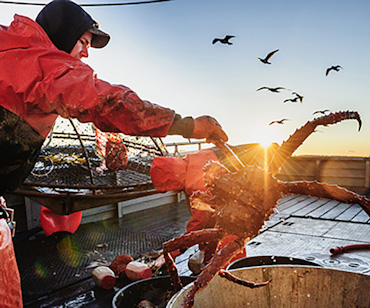Sponsored Content
Sea Exploration
Chefs Elevate Seafood Dishes with Sea Vegetables
There’s a garden under the sea that chefs have yet to fully explore. Highly nutritious and sustainable sea vegetables are popping up on restaurant menus, as commercial seaweed farming operations expand in the U.S. Chefs are loving the umami flavor of dulse, nori, kelp, kombu and hijiki in all its forms. But there’s no more natural pairing for these nutrient-dense, mineral-rich greens than with Alaska seafood.
“What grows together goes together,” says Travis Haugen, chef/owner of Southside Bistro in Anchorage, Alaska. “If it’s from the same habitat or environment usually it’s a natural pairing.” Used in broths and sauces, sea vegetables typically play a supporting role in Haugen’s dishes. He pairs fried Alaska cod or halibut with seaweed mayonnaise, finishing the dish with crispy kelp confetti.
“It’s one of those flavors that helps enhance everything,” adds Haugen. “It is almost like salt in a dish. It makes the rest of the dish more savory or interesting to our palate.”
Seaweeds are a natural source of glutamates—amino acids that react with receptors on the tongue to create the umami taste. With few commercial operations in the U.S., chefs here primarily use dried seaweed.
“You don’t think of seaweed as something you can grab out of the ocean and eat,” says Chef/Owner Adam Hegsted of Wandering Table in Spokane, Wash. “It tastes like lettuce, with a little saltiness,” says Hegsted.
Hegsted primarily uses sea vegetables in salads, garnishes and dashi-style broths. He pairs Dungeness crab with seaweed, cucumbers and green onions in a salad served with creamy sesame vinaigrette.
“The sweetness from the seaweed and the crab marries well together,” explains Hegsted. “You get this surprising pop of seaweed texture.”
Hegsted also rubs a dried seaweed blend on Alaska scallops, salmon and shrimp. Fish are wrapped in kelp and roasted on the grill. He likes to pair the familiar with the unfamiliar. Pickled bullwhip kelp is used in place of pickles on a salmon burger. “It tastes just like cucumber,” he says.
Seaweed is also a strong supporting player at Sitka and Spruce in Seattle, Wash. Fermented and smoked fish carcasses and seaweed are used in a broth that is a base for many dishes.
“The umami flavor comes through in soups, sauces, dressings and marinades,” says Chef/Owner Matthew Dillon. Filets of Alaska sablefish (black cod) are laid on seaweed and dry aged for two days.
Being part of the same ecosystem, he calls Alaska seafood and seaweed “the perfect combination.”
Seafood Sense: Make it Sustainable and Healthy

Consumers want to eat healthier without sacrificing flavor. In a recent study*, 54% of diners said they want restaurants to serve a wider variety of seafood, and 45% want seafood entrees with new or unique flavors. “With the commercialization and rise of the seaweed industry it is the perfect time for chefs to capitalize on this nutritious bounty to further tell the unique Alaska Seafood story,” says Megan Rider, marketing manager with the Alaska Seafood Marketing Institute.
Wild-caught, sustainable Alaska seafood appeals to socially-conscious diners and chefs. Mathew Dillon, chef/owner of Sitka and Spruce buys flash-frozen seafood in bulk, direct from a family-owned fishery in Sitka, Alaska. “It’s important to me to support the small fisherman,” says Dillon.
“To ensure sustainability we try to develop relationships with the seafood vendors we are doing business with,” says Adam Hegsted, chef/owner of Wandering Table in Spokane, Wash. He believes utilizing a wide variety of fish and shellfish from Alaska can be good for sustainability and a restaurant’s bottom line.
Travis Haugen, chef/owner of Southside Bistro, concurs that using a variety of Alaska seafood is good for sustainability. Based in Anchorage, Haugen keeps a close eye on Alaska fisheries. “Our fisheries do not over fish and they are careful about how they manage supply and demand,” he says. “They are doing a very good job of managing the resources and keeping them available for everybody.”
Sustainability is so important in Alaska, it’s the only state to write it into its constitution—and it’s been that way since 1959. All Alaska fisheries are certified through Responsible Fisheries Management, a comprehensive third party certification program founded on the strongest and most widely acknowledged international standards and practices.
Alaska Seafood Sustainable Combos
- Alaska cod or halibut with seaweed mayonnaise
- Grilled Alaska scallops with seaweed butter
- Nori-wrapped roasted Alaska rockfish
- Alaska clams steamed in kelp broth
- Alaska pollock taco with kelp salsa
- Seared Alaska salmon with kombu broth and vegetables
- Alaska Cioppino with dashi broth
- Alaska salmon burger with wakame slaw
- Log in or register to post comments
